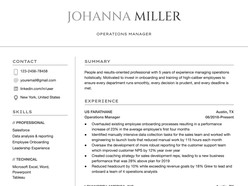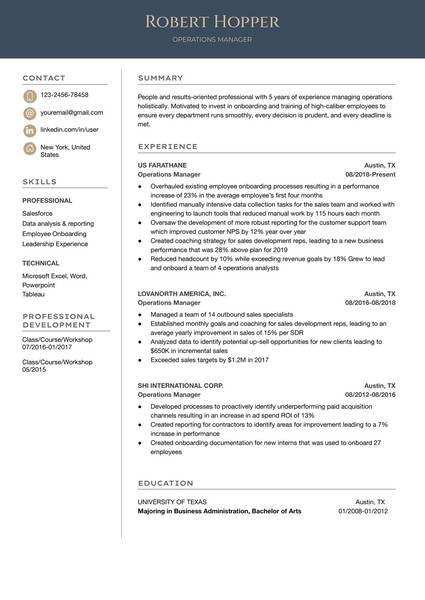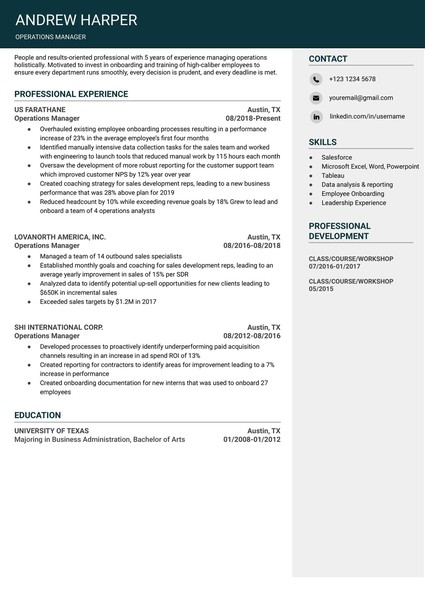How to Download and Use the Templates
Follow these steps to access and customize a Google Docs template efficiently:
- Browse Available Templates
Review the curated collection and identify a format that aligns with your event style and scheduling needs. - View Template Details
Select a template to open its dedicated detail page, where layout structure and key features are outlined. - Download the Template
Click the Download Template button to open the document directly in Google Docs. - Start Editing in Google Docs
In the opened document, select Use Template (top-right corner) to generate an editable copy. - Sign In to Google
Make sure you are signed into a Google account — this is required to save, personalize, and begin editing the template.
Once saved, the template becomes a fully customizable document — ready for editing, printing, or digital sharing with minimal setup.
How to Write an Effective Operations Manager Resume in Google Docs
Operations managers are hired to solve complexity — not create it. Your resume should reflect that. A well-structured operations resume must show how you improve workflows, scale systems, reduce costs, and lead teams with precision. It must also communicate those strengths clearly and quickly.
This guide breaks down how to build a high-performing operations manager resume using Google Docs — with a focus on structure, impact, and results over fluff.
1. Start With a Strategy-Focused Summary
Why it matters: Recruiters skim. If your resume doesn’t lead with the scope of your operational ownership, they won’t keep reading.
What to include:
Total years in operations or supply chain leadership
Team size or department scope (e.g., “led cross-functional team of 25 across logistics and procurement”)
Core strengths: efficiency, change management, Lean Six Sigma, ERP/CRM oversight, vendor management
A brief note on industry familiarity (e.g., SaaS, eCommerce, healthcare systems)
Google Docs lets you format this section cleanly with bold headers, bullet separators, or simple layout grids — without complicated software.
2. Translate Actions Into Operational Impact
Why it matters: Hiring managers want more than duties — they want outcomes. Especially in operations.
How to write bullet points:
Use a structured format:
Action + Area + Outcome
Examples:
“Redesigned warehouse workflows to reduce order fulfillment time by 22%”
“Led implementation of ERP system across three divisions — cut manual reporting by 60%”
“Negotiated vendor contracts saving $320K annually across supply chain”
Stick to 3–6 bullets per role. Prioritize initiatives that saved time, money, or reduced errors. Google Docs formatting tools make it easy to align bullets and maintain consistent spacing across entries.
3. Include the Right Tools and Certifications
Why it matters: Ops managers often work across software stacks, compliance systems, and logistics platforms.
What to include:
Platforms: SAP, Oracle, Salesforce, Asana, NetSuite, Microsoft Dynamics, etc.
Methods: Six Sigma (any belt level), Lean, Agile, Kanban
Tools: Excel (pivot tables, macros), SQL, Tableau, Power BI
Certifications: PMP, APICS, Certified Operations Manager, etc.
Create a "Skills & Tools" section that lives below your summary or after your experience, depending on your formatting preference. Keep it compact but focused on real systems you’ve used.
4. Organize Experience to Highlight Scale and Evolution
Why it matters: In operations, growth over time matters — show how your roles evolved in complexity, team scope, or cost responsibility.
Structure suggestion:
Company name, role title, years
One-sentence role summary (scope, location, direct reports)
Bullet points focused on measurable initiatives
Use consistent formatting across roles. For promotions within the same company, nest titles with dates and show growth clearly. Google Docs' outline tools and tabbing system help maintain clarity.
5. Keep Length and Layout in Check
Why it matters: An operations resume that looks chaotic can instantly contradict the candidate’s purpose.
Tips:
Keep it to 1–2 pages
Use one font family, 11–12 pt for text, 14–16 pt for headers
Avoid sidebars, logos, or multi-column formats — they often break in ATS systems
White space is strategic: it helps your key points stand out
Google Docs templates help keep structure consistent — you can duplicate, export, and customize without version issues.
Why Google Docs Works for Operations Resumes
Structured Formatting — Build clean layouts without formatting errors
Real-Time Editing — Collaborate with mentors, recruiters, or peers instantly
Cloud Access — Update between meetings, interviews, or site visits
Simple PDF Export — Deliver final documents professionally without software bloat
Operational Excellence Starts With a Clear Resume
An operations manager’s resume should reflect what they do best — bring order, clarity, and measurable performance to complex systems. With the right structure and language, even a simple Google Docs file can become a strategic career asset.
From procurement leadership to system implementation, your resume isn’t just a summary — it’s a demonstration of how you drive results across moving parts.











